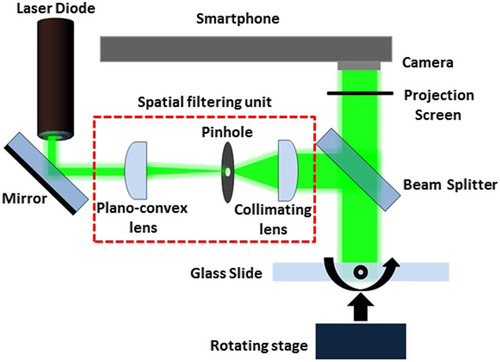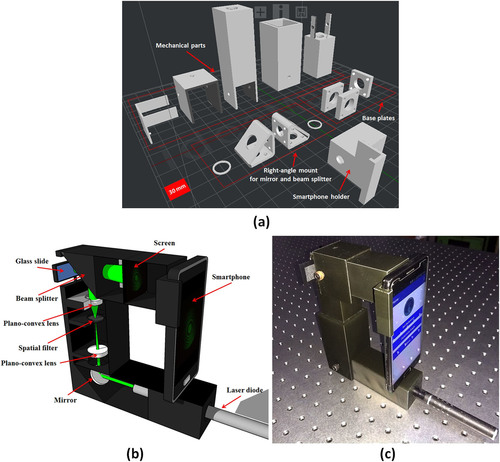Smartphones serve many functions, including that of scientific instruments. With a little tinkering and 3D printing help, makers have turned smartphones into things like microscopes, and in a paper entitled “Design of a 3D printed compact interferometric system and required phone application for small angular measurements,” a pair of researchers document how they used 3D printing and a smartphone to create an interferometer, a scientific instrument that takes precise measurements through the interference of two beams of light.
“The working principle of the proposed interferometer is based on the formation of circular interference fringes due to the reflection of the monochromatic light beam from the top and inner bottom face of a microscopic glass slide,” the researchers explain. “The optical path difference (OPD) between these two interfering beams can be varied by changing the inclination angle of the glass slide with respect to the incident light beam. The central bright fringe gradually changes to dark fringe with the change in OPD, and consecutively there is a variation in the fringe order with angular rotations. The smartphone camera has been used to record the interferogram, and then it is processed by the custom designed application for automatic calculation of the change in the fringe order, the pixel shift of the interferogram from the initial position and intensity variation of the central fringe to calculate the angular rotation of the glass slide.”
The opto-mechanical components for the system were all developed using ZW3D CAD software and then 3D printed on a Raise N2 Plus 3D printer. Optical components such as a lens and pinhole were mounted to the 3D printed components. The phone itself is equipped with a 13 megapixel count CMOS sensor with high resolution. An Android application was developed for onboard fringe processing and automatic evaluation of angular rotation of the glass slide.
“The usability of the designed optical tool has been demonstrated for the monitoring of small angular variations with high precision and reliability,” the researchers conclude. “The smartphone has been visualized as a platform for automated complex fringe analysis and interferometric data processing which is a critical point in any interferometry based sensing applications. The required opto-mechanical parts for the present work have been obtained from 3D printing technology which reduces the overall fabrication cost of the designed interferometer. In the future, the applicability of the proposed device will be demonstrated for more complex interferometry based applications such as determination of thin film thickness and refractive index with the required optimizations in the device parameters.”
3D printing has been used to create all sorts of low-cost laboratory equipment, including reactors, drug testing systems and much more. The purpose of the researchers’ paper was to demonstrate that a complex interferometer could be created using accessible, inexpensive means – a smartphone and 3D printed components. Not only is the device inexpensive, it’s user-friendly and compact, making it portable enough to take anywhere in the field. These are the advantages of 3D printing – the ability to take complex tools and reduce them to only a few components, drastically cutting back on cost and size.
Authors of the paper include I. Hussain and P. Nath.
Discuss this and other 3D printing topics at 3DPrintBoard.com or share your thoughts below.
Subscribe to Our Email Newsletter
Stay up-to-date on all the latest news from the 3D printing industry and receive information and offers from third party vendors.
You May Also Like
3D Printing News Briefs, April 13, 2024: Robotics, Orthotics, & Hypersonics
In 3D Printing News Briefs today, we’re focusing first on robotics, as Carnegie Mellon University’s new Robotics Innovation Center will house several community outreach programs, and Ugogo3D is now working...
Rail Giant Alstom Saves $15M with 3D Printing Automation Software 3D Spark
3D Spark has entered into a three-year deal with the rail giant Alstom. Alstom, a transport behemoth with annual revenues of $16 billion, specializes in the manufacture of trains, trams,...
Meltio Expands Global Reach with New Partnerships in the Americas and Europe
Spanish 3D printing manufacturer Meltio has expanded its sales network across the globe. With the addition of three new partners in the United States, Brazil, Argentina, and Italy, Meltio aims...
3D Printing Webinar and Event Roundup: April 7, 2024
Webinars and events in the 3D printing industry are picking back up this week! Sea-Air-Space is coming to Maryland, and SAE International is sponsoring a 3D Systems webinar about 3D...

































